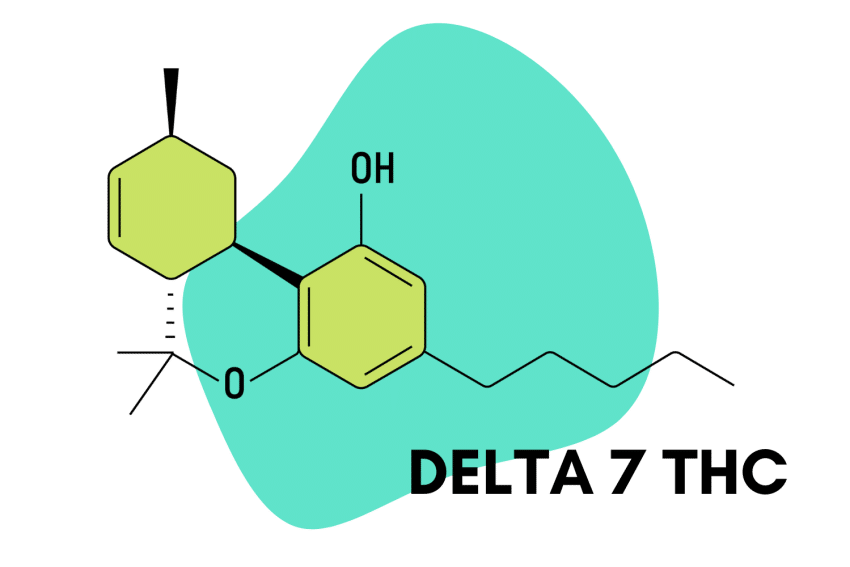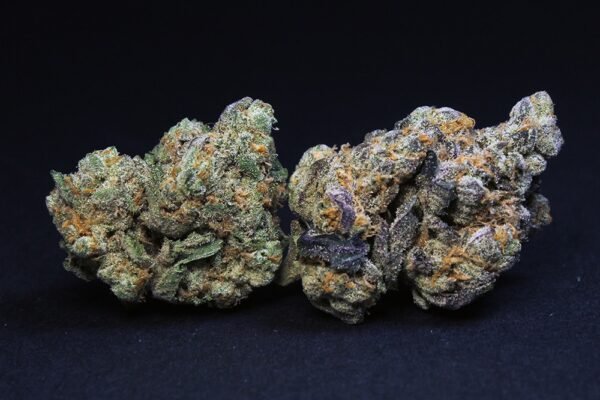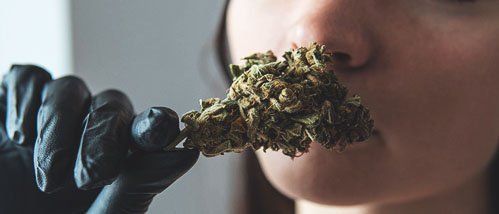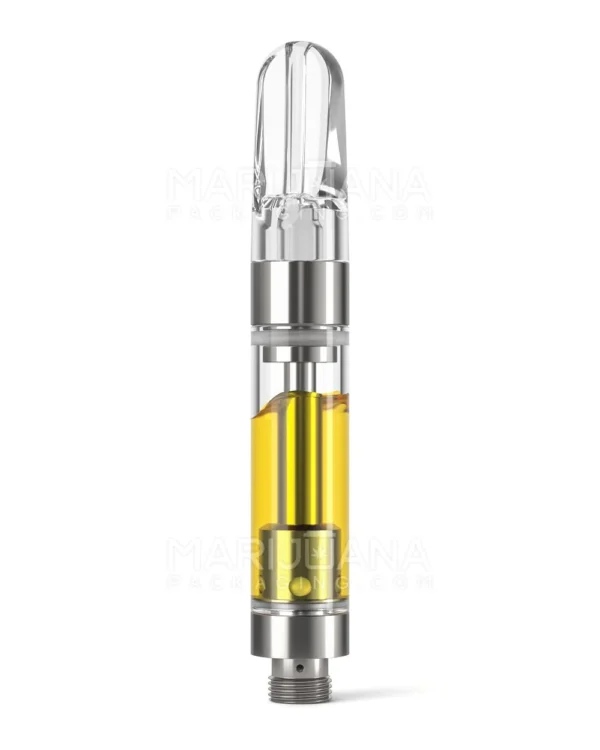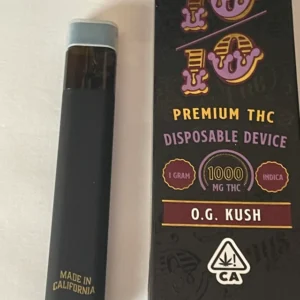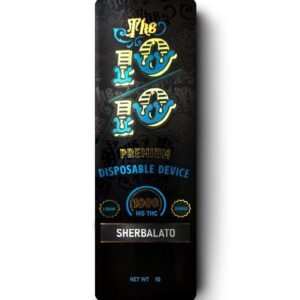Cannabis
A Complete Guide to the Lesser-Known Delta-7 THC
Delta 7 THC: Specs & Technical Details
| Active Ingredient | Delta 7 THC |
| Level of Risk | Low |
| Other Names | Δ7, D7, Delta 7 |
| Most Common Side Effects | Red eyes, increased appetite (“munchies”), increased heart rate, feelings of anxiousness |
| Duration of Effects | 2-10 hours, depending on the delivery method and dose |
| Legal Status | Legal in the United States (if derived from hemp). Some states may have restrictions. |
How Does Delta 7 THC Work?
Like most cannabinoids, delta 7 THC is believed to interact primarily with the endocannabinoid system (ECS), a complex network of receptors, signaling molecules, and enzymes that help regulate critical physiological processes like mood, stress, immune function, sleep-wake cycle, and pain perception.
There are two main types of receptors in the ECS:
- CB1 Receptors: Concentrated in the central nervous system
- CB2 Receptors: are primarily located in the immune cells and peripheral tissues
As a THC molecule, delta 7 is believed to have an affinity for CB1 receptors.
The activation of CB1 receptors is responsible for a wide range of effects, which most notably include:
- Psychoactive effects (feelings of euphoria and altered sensory perception)
- Appetite stimulation
- Pain relief
Some cannabinoids, like delta 9 and CBD, interact with other receptor sites involving relaxation, pain relief, anti-inflammation, and more [1, 2].
However, since the delta 7 THC cannabinoid is newer to the scene, there’s still a lot that’s unknown about how it works and the safety of its long-term use.
What Does Delta 7 THC Feel Like?
The molecular shape of cannabinoids is important because they kind of work like keys to the locks of receptor sites. When the keys activate these sites, it initiates a chain of actions that affect different physiological processes.
The subtle difference of having the double bond on the seventh carbon atom means that it doesn’t have as strong of a bond to CB1 receptors, giving it much milder effects compared to delta 9 THC. Yet, it’s still enough to produce a noticeable high that can result in the following positive outcomes, depending on the dose:
- Heightened sensitivity to music, colors, and taste
- Increased appetite
- Feelings of euphoria and an uplifted mood
- Altered perception of time (time tends to move very slowly)
- Deep relaxation in the body
- Relief from pain
Delta 9 THC vs. Delta 7 THC Comparison
As we’ve briefly mentioned, delta 9 THC is the most common form of THC found in cannabis and the primary cannabinoid responsible for the marijuana high.
When consumed, the shape of the delta 9 THC molecule has an affinity for CB1 receptors in the central nervous system, which play an important role in regulating mood, appetite, pain perception, memory, and cognition.
Most people report feeling a sense of euphoria, deep body relaxation, altered thought patterns, and an increased desire for food (aka the munchies).
While these are the desired outcomes, THC can also produce some negative side effects like anxiety and paranoia, which tend to happen in higher doses or in people more sensitive to it.
This is where THC isomers like delta 7 can come in handy.
The shape of the delta 7 molecule doesn’t give it as strong of an affinity to the CB1 receptors. However, it’s still enough to produce a subtle high that’s much more forgiving than a typical marijuana high.
Of course, the effects of delta 7 can vary from individual and the dosage. Still, it’s usually sought out as a gentler alternative.
Side By Side Comparison of Delta 9 & Delta 7
| Delta 9 THC | Delta 7 THC | |
| Chemical structure | Double bond on the 9th carbon chain | Double bond on the 7th carbon chain |
| Psychoactive effects | Potent psychoactive effects | Mild psychoactive effects |
| Legal status | Listed as a Schedule I controlled substance in the US (in concentrations greater than 0.3% by dried weight). | Not explicitly listed as a controlled substance when made from hemp. Laws vary by state. |
| Medical Potential | Well-studied with potential therapeutic benefits, including pain relief, appetite stimulation, and nausea reduction. | Some studies suggest anti-inflammatory and pain-relieving properties. |
| Availability | Commonly found in most strains of cannabis, well-studied, and widely available. | Rarely found in cannabis strains and not as widely available for purchase. |
Current Research on Delta 7 THC
What we know about delta 7 THC and its effects are mostly based on anecdotal reports. It shows many of the same effects as other THC cannabinoids, such as relaxation, pain relief, and appetite stimulation.
Since most of the research on cannabis compounds centers around delta 9 THC and CBD, we don’t know much about how THC isomers work in the body.
The rise in interest in THC isomers came about when hemp was legalized in the United States with the 2018 Farm Bill.
Before this, the cultivation and use of cannabis — including hemp — and its derivatives were heavily restricted in many parts of the United States, thus limiting the ability of researchers to study these compounds.
Research on delta 7 is in its early stages, and many of which are conducted on animals, but, likely, the trend of exploring all cannabis has to offer will result in more interesting developments and new products.
One study, in particular, looked at six different cannabinoid structures, including delta 9 THC, delta 8 THC, and delta 7 THC, to understand how their structures relate to their activity.
The researchers found that the orientation of the carbocyclic ring in each molecule determined its activity and that the unique structural shape of these THC isomers plays a pivotal role in the activity of these cannabinoids [3].
How Is Delta 7 THC Made?
Delta 7 THC is not typically found in large quantities in cannabis plants, so it’s synthesized from other cannabinoids such as delta 8 THC or, more popularly, CBD, as it’s an abundant cannabinoid in hemp.
The process is called isomerization, and it involves acids to chemically transform the molecular structure of the original cannabinoid into the desired compound. This can’t be done at home, as it requires precision and heavy-duty lab equipment to execute.
As long as the manufacturing process is done professionally and has third-party lab testing to verify that the final product is free from residual chemicals, you should have a safe delta 7 THC product.
How to Dose Delta 7 THC
As a newer cannabinoid, delta 7 isn’t as widely available as CBD or THC (delta 9 and delta 8), so there’s still little information on dosing recommendations. How Is Delta 7 THC Made?
The best compound we can compare it to for dosing is delta 9 THC, as it’s arguably the most well-known THC cannabinoid. How Is Delta 7 THC Made?
According to anecdotal reports, compared to delta 9, delta 7 has much milder psychoactive effects, so it may take larger doses to achieve the same intense high with recreational marijuana.
But other factors can affect the proper cannabinoid dosing for an individual, including:
- Experience with cannabinoids (tolerance)
- Weight
- Metabolism
- Underlying health conditions
The standard psychoactive dose of delta 9 THC is around 5 mg. This is where its psychoactive effects are noticeable.
But because delta 7 is much weaker than delta 9, it’s common to see recommended doses from experienced users and brands offering delta 7 THC products starting at 10-15 mg — double to triple the amount of delta 9 products.
The effects can last anywhere from 2-10 hours, depending on the dose and how it was administered.
Typically, eating delta 7-infused products lasts much longer than vaping or smoking the compound.
1. Microdose
Microdosing THC is a technique that’s become recently popular for those who may want to manage symptoms such as pain, anxiety, or nausea without experiencing strong psychoactive effects.
While some people claim to benefit from microdosing THC, no scientific evidence supports the claims.
The microdose for delta 9 THC is 0.5–1.5 mg, so we can assume that delta 7 is about 1–3 mg.
The goal of a microdosing practice is to experience the potential therapeutic benefits of THC without getting high, so if it feels like nothing, you’re probably doing it right.
2. Low Dose
A low dose is a suitable option for those who want to manage symptoms such as pain, nausea, and anxiety without a full-blown psychoactive dose.
One of the reasons people might seek delta 7 and even delta 8 THC products is because of their milder nature. It’s not as easy to overdo the doses, so you can avoid feeling overwhelmed by the psychoactive properties that can impair cognitive function or cause drowsiness.
A low dose of delta 7 THC is around the 5 mg mark.
3. Standard Psychoactive Dose
Some people may choose a standard psychoactive dose with delta 7 THC for its euphoric effects. It can help improve mood, promote deep relaxation, and create more enjoyable sensory experiences.
At the same time, reaching a psychoactive dose of THC can be used for medicinal purposes to manage stronger symptoms of pain and anxiety.
Because delta 7 is much weaker than delta 9, reaching these effects will take a significantly higher dose. The standard psychoactive dose for delta 7 is around the 10–15 mg mark.
4. Heavy Dose
Unless you’ve got some THC experience under your belt, we don’t recommend even a heavy dose of even the milder delta 7 THC.
It can cause impairment in cognitive function, drowsiness, and in some cases, may increase anxiety and paranoia.
However, some individuals may want a heavy dose of THC to address pain symptoms. Delta 9 THC might be a better fit in these instances, as it requires smaller amounts to reach this state.
Nevertheless, you can reach a heavy dose with delta 7 THC with doses upwards of 25 mg.
What Are the Side Effects of Delta 7 THC?
Delta 7 THC is a relatively new compound, and there is currently limited research on its potential side effects. However, it is a form of THC, which is known to have common side effects, especially at higher doses.
Some potential side effects of THC, including delta 7, may include:
- Euphoria
- Feeling “high”
- Dry mouth
- Red eyes
- Increased heart rate
- Decreased blood pressure
- Impaired memory or concentration
- Dizziness or lightheadedness
- Anxiety or paranoia
- Psychosis, in rare cases
Is Delta 7 THC Legal?
In the United States, the legal status of delta 7 THC depends on its source.
If it’s derived from hemp — a cannabis plant containing less than 0.3% delta 9 THC — then it is legal under federal law as per the Farm Bill (2018).
However, some states have different regulations regarding THC variants from hemp.
The following states have banned the sale of all THC isomers:
- Alaska
- Arizona
- Arkansas
- Colorado
- Delaware
- Idaho
- Iowa
- Kentucky
- Mississippi
- Montana
- Rhode Island
- Utah
- Vermont
This means that if you’re purchasing a delta 7 product online, it may not ship to your area, and if you get caught with it, you could face legal consequences. These laws are constantly in flux, so make sure you stay up to date

